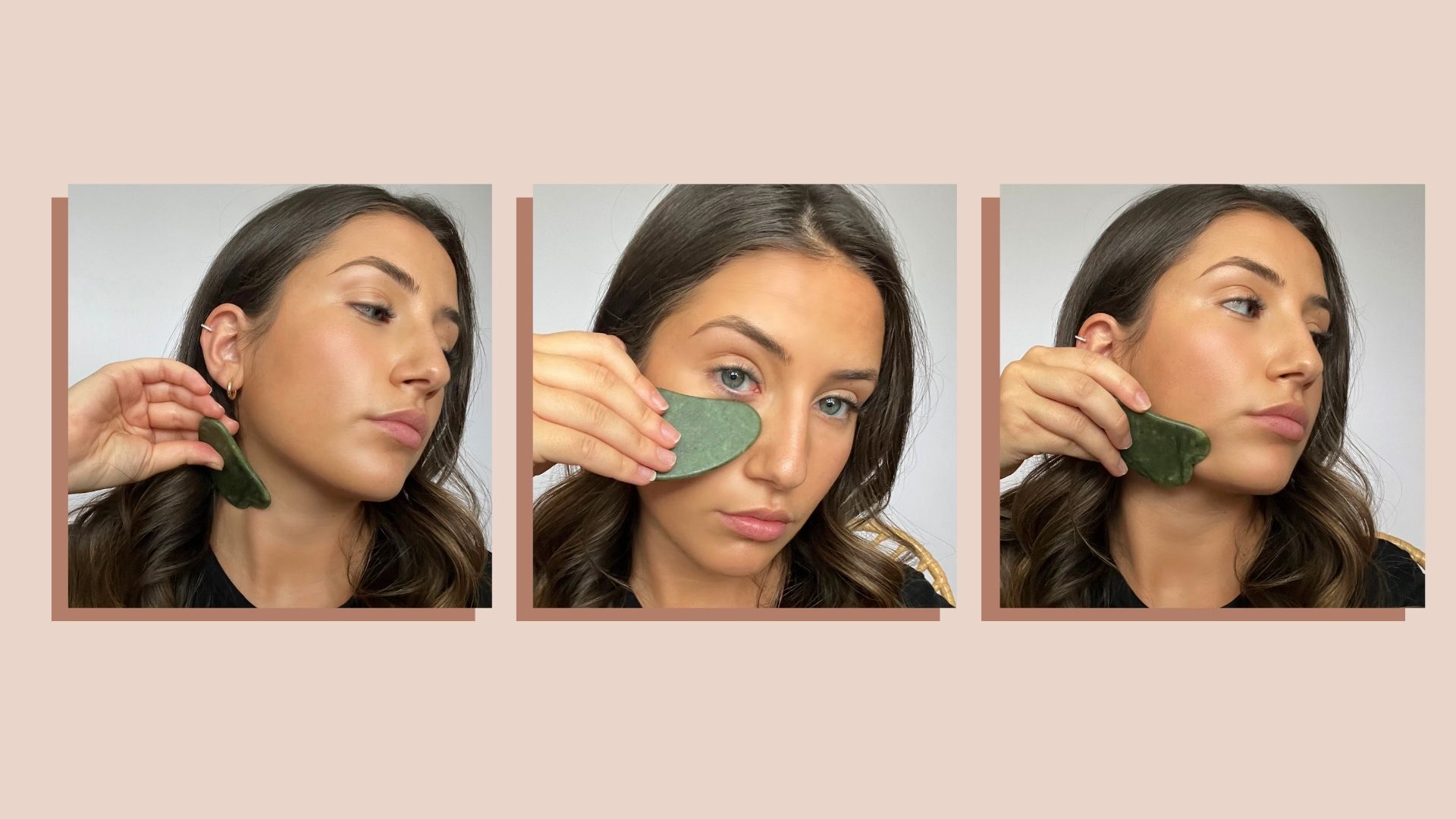How to use gua sha: our beauty team's step-by-step guide for energized, glowing skin
Wondering how to use gua sha? Experts explain the benefits, techniques, and what you definitely *shouldn't* do


Debra Waters
Ever wondered how to use gua sha? Not just an easy self-care practice, this traditional Chinese medicine technique boasts an impressive list of benefits. Loved by celebrities such as Gwyneth Paltrow and Elle McPherson for visible skincare results, gua sha tools are something of a sensation – and for a good reason.
You may not think using even the best gua sha tools is an essential part of your skincare routine like your cleanser or moisturizer – but I am here to tell you I have seen truly amazing results from regular use. Using gua sha turns my skincare routine into a moment of mindfulness. My skin feels sculpted and plumped and plus the blood flow boost I get to my face every morning works wonders on my complexion.
Gua sha expert and founder of the Hayo'u Method, Katie Brindle, believes it is the single most effective technique for transforming your skin. I spoke to Brindle as well as skin expert and founder of the WOW Facial, Claire Williams, and Dr Usman Qureshi, a leading aesthetic doctor, to find out more and help you start your gua sha journey.
How to use gua sha, an expert guide
What is gua sha?
Before learning how to use gua sha, it is essential to understand what gua sha is. "Facial gua sha is a simple massage technique using a round-edged tool. It's been widely practiced in China for thousands of years. 'Gua' means to press-stroke, whilst 'sha' describes the temporary red flush that results", explains Brindle.
Williams adds, "Gua sha scrapes your skin with short or long strokes to stimulate microcirculation of the soft tissue, which increases blood flow." And the positive effects don't stop there. "The tool allows you to work deeply into the muscles and fascia for superb tension release, removing the build-up of lactic acid and encouraging lymphatic drainage," explains Brindle. "The curved points activate specific acupressure points on the face to ensure the smooth flow of qi and blood".
Skincare benefits of gua sha
And what skincare benefits can you expect from all that release and stimulation? "The technique stimulates the dermis to support collagen and elastin production and releases tension to relax your facial muscles. Studies have shown it to increase circulation and aid lymphatic flow; release congestion and soothe sore eyes and skin, brighten your complexion and leave you with a radiant glow", explains Brindle. Who doesn't want glowing skin? That radiant effect is the reason I'm sold, but is far from the only reason to learn how to use gua sha, which are:
- Boosts collagen and elastin
- Supports lymphatic drainage
- Improves the appearance of fine lines and wrinkles
- Releases deeply held tension.
- Offers anti-inflammatory benefits
- Plumps the skin by clearing qi stagnation in the face
- Brightens by stimulating blood flow.
For an extra cooling effect, I love putting my gua sha tool in the fridge. Not only does this feel amazing, but, according to Katie, the coolness of the tool "is also beneficial if you suffer hot flushes or itchy eyes associated with hay fever symptoms''. She adds, "When held over hot skin or sore eyes, it will instantly help relieve discomfort". Dr Usman also states that gua sha is great for relieving sinus tension. What's not to love?
Sign up to our free daily email for the latest royal and entertainment news, interesting opinion, expert advice on styling and beauty trends, and no-nonsense guides to the health and wellness questions you want answered.
How to use gua sha

w&h Beauty Assistant Darcy shows how to use gua sha tool on different areas of the face.
- Step 1: Generously lubricate the skin with oil, moisturizer or serum.
- Step 2: Press the tool gently all over your neck, face, and décolletage.
- Step 3: Press and hold the tool under each eye, then over each eye, with the lid shut.
- Step 4: Starting under the jawline, press, and stroke downwards on either side of the neck to drain excess fluid into the lymph glands, taking extra care to avoid the windpipe.
- Step 5: Angling the tool at 45 degrees in the direction you want to work, use the rounded edge to press-stroke the forehead, the cheekbones, then the lips – about eight sweeps in each direction.
- Step 6: Use the double-curved end on your throat and jawline.
When learning how to use gua sha, patience is key. "Never do gua sha in a rush," says Dr Usman. Another non-negotiable is using the best facial oil, your best face moisturizer or even your best retinol cream to lubricate the skin. Brindle explains, "You need to apply oil to have sufficient 'slip', so the tool can glide easily to avoid dragging delicate facial skin. If you use your gua sha tool in the shower, lubricate your skin with water."
Things not to do with your gua sha
- Using it on dry skin: "Gua sha or any other face tool for that matter should be used on hydrated skin. Your skin should be slippery and moisturized for the tool to work its wonders without causing any irritation". I had to learn that the hard way, so trust the experts on this one! Plus a well-hydrated face will make adding a dewy makeup look to your post gua sha glow easy.
- Not using both hands: "Most people tend to use a gua sha tool with one hand, which may create friction and curb you from making the most out of the pamper session. Use both hands: one to hold the stone and the other to hold your skin firmly. Doing this gives the right push to your skin, ensuring proper sculpting. This is most important when using the stone around your cheeks".
- Overdoing it: "A lot of people end up overdoing the gua sha massage session because they're in a hurry to reap the results. A 10-minute massage once or twice a day is all that you need. Overdoing it will only harm your skin and slow the progress," explains Dr Usman, who states that once a day is enough to enjoy the best results, however you can still experience benefits if you use gua sha ''two to three times a week''. Personally, I find using gua sha once in the morning is enough. But, if you want to carry on your at-home spa day you could try using other skincare devices for specific skin concerns.
How to use gua sha for specific skin concerns
How to use gua sha for acne
"If you have something like acne, you should also avoid using the rounded edge of the tool directly over the inflamed skin as this can potentially cause the infection to spread''. But gua sha can be used as part of your skincare routine for acne. ''You can use the flat of the tool to cool the area and. You can also gua sha around inflamed blemishes as this will help draw toxins and stagnation away from the area where they can be eliminated via lymphatic drainage. Once a blemish has healed, gua sha can be very helpful in reducing any residual marks". Try using gua sha on clean skin after your best cleanser for acne to treat and prevent breakouts.
How to use gua sha for rosacea
"If you have rosacea, it is best not to do the press stroke technique. Rather, use the rounded edge of the tool to sweep over the contours of the face',' says Brindle. There is a benefit to including gua sha in your skincare routine for rosacea. ''You can hold the naturally cool crystal over the affected area and allow it to warm up gently. This will begin to take the heat out of the skin, which will be very helpful in soothing the condition. Once the tool has warmed up, you can turn it over and repeat''. Rosacea skincare buys like gentle cleansers and sunscreen are great to use alongside this technique.
How to use gua sha around raised moles
"For large, raised moles, we recommend working around the area to avoid the risk of inadvertently knocking and damaging the skin''. Naturally, it's always smart to be extra cautious, check whether it is a skin tag or a mole, and check larger, raised areas of pigmenataion for signs of cancerous moles.
Who shouldn't use gua sha?
"Facial gua sha, in some form, really is suitable for almost everyone because the practice is so versatile, " explains Brindle. "The technique can be performed so gently, and the tools can be used in various ways; even the most sensitive, fragile, or troubled skin can benefit. However, caution is advised if you have recently had an injectable treatment such as baby Botox. "If you have had cosmetic procedures such as Botox or dermal fillers, we advise against gua sha directly over the treated area for about four weeks after treatment. However, you can continue using the tool on other areas.''
When can you expect to see results?
The results of my gua sha use were pretty instant, and I love the ritual using gua sha adds to my skincare routine. Brindle says that ''the results are both instant and cumulative, but it is when practiced regularly that you really start to see a fundamental change in your skin’s tone, elasticity, and radiance."
She continues, "This is because gua sha continues to flood the skin with fresh nutrients, boosting levels of collagen and elastin to smooth and plump. You get the type of glow that comes from a good night’s sleep or a long country walk. Great skin is a reflection of your interior health, and that really is beautiful, whatever age you happen to be.’'

Darcy Brown is a print and digital beauty journalist with her finger on the pulse of the latest trends. She entered the industry as an intern for publications such as Fabulous Magazine and the Sun. Since graduating from university with a first-class BA Hons degree in Philosophy, she has thrown herself into all things beauty.
When she's not writing for Woman & Home and Weekly titles including Woman and Woman's Own, you can find Darcy working on editorial shoots and social media campaigns with some of the industry's leading experts, including George Hammer, Angelo Seminara, and Lan Nguyen Grealis.